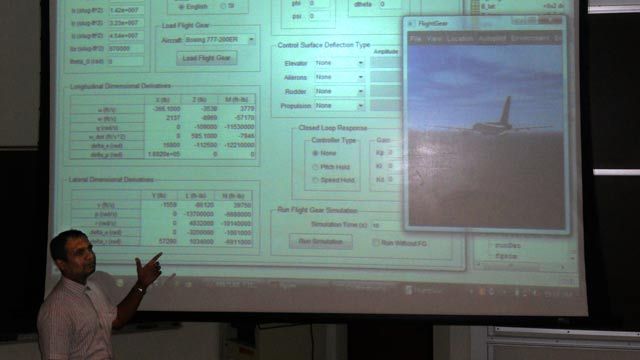Arizona State University Develops Innovative Aerospace Engineering Curriculum
“Our students are really teaching themselves aerodynamics concepts using MATLAB. They run computations, analyze and visualize the results, and draw conclusions. Once they see how the concepts work, I show them the theory. This approach builds students’ confidence and motivates them to keep learning.”
Challenge
Solution
Results
- Students’ confidence increased
- Final exam scores improved by 18%
- Lab time conflicts eliminated

Faculty in the Aerospace Engineering program at Arizona State University (ASU) have revamped the curriculum to increase students’ learning motivation and better prepare them for industry. Supported by NASA’s Innovation in Aeronautics Instruction program, the new curriculum developed by Dr. Valana Wells and Dr. Praveen Shankar emphasizes independent discovery and the use of computational tools to explore aerodynamics and aircraft stability and control concepts.
Because MATLAB® and Simulink® are more deeply integrated in third-year courses, students perform numerical simulations and visualize concepts before they master the underlying theories. “Our third-year students use MATLAB and Simulink in almost every course,” says Dr. Wells, program chair for Aerospace Engineering and Mechanical Engineering at ASU. “With our new instructional approach, students gained confidence, were more engaged in active learning, and performed significantly better on exams.”
Challenge
To solve aeronautics problems, engineers in industry use computational methods for design and analysis. Teaching, however, still emphasizes classical methods, mostly based on the derivation and analysis of symbolic linearized models.
“For some time, we have wanted to incorporate more computational work to prepare students for industry,” explains Dr. Wells. “Rather than focus on the specifics of deriving the theory, we wanted to emphasize the important concepts.”
ASU also wanted students to build confidence in their ability to succeed in industry after graduation. Studies at ASU showed that as the curriculum becomes more difficult, students can lose motivation and question their career choices. Engaging students with active learning techniques and demonstrating the value of their coursework were key objectives in improving confidence and motivation.
Solution
ASU revamped two core aerospace engineering courses to emphasize the discovery of critical concepts through real-world problems. They also provided widespread access to MATLAB and Simulink for students and faculty by implementing a Campus-Wide License.
In the course Aerodynamics, students use MATLAB to investigate the effects of airfoil shape and operating conditions. Undergraduates use a MATLAB based GUI, developed by graduate student Manoj Mahendran, that is integrated with commercially available computational fluid dynamics (CFD) software.
After specifying various airfoil geometries and conditions, students run the CFD computations and analyze results with MATLAB.
“Students are introduced to MATLAB as freshmen, so they are familiar with the environment and can easily perform this kind of sophisticated analysis,” says Dr. Wells.
In Aircraft Dynamics and Control, students use MATLAB and Simulink to investigate the effect of various aircraft configurations on flight dynamics and stability. Using a SolidWorks® aircraft assembly, students specify parameters such as tail size and wing span. Then, they import the assembly into MATLAB and create an input file for the USAF Stability and Control Digital DATCOM program to estimate the aerodynamic stability and control characteristics of the aircraft.
These aerodynamic characteristics are imported into MATLAB using Aerospace Toolbox and implemented in a Simulink model, which integrates with a FlightGear flight simulator using Aerospace Blockset™ FlightGear interface blocks. The students can then simulate their aircraft model from a MATLAB GUI, developed by Dr. Shankar and graduate student Evan Schentrup.
Because the Simulink model is integrated with the FlightGear simulator, students can visualize the aircraft flying while the simulation runs and immediately see the effects of different configurations and control strategies.
“MATLAB was chosen because it not only provides a simple framework to integrate various third-party applications such as DATCOM and FlightGear but also allows users to execute them in a familiar environment,” says Dr. Shankar.
MathWorks tools are incorporated in several other courses, including Control System Design, in which students use Control System Toolbox™ to perform root locus analysis, and Sensors and Controls, in which honors students model a physical system with Simscape Multibody™ and develop a controller for it with Simulink.
Results
Students’ confidence increased. “We conducted a study to compare student performance in the former and new courses,” says Dr. Jenefer Husman, associate professor at ASU. “We found that the new courses profoundly improved the students’ confidence in their ability to achieve course objectives.”
Final exam scores improved by 18%. “In the Aircraft Dynamics and Control course, we gave the same final exam for two years,” explains Dr. Shankar. “Students in the new course, which incorporated MATLAB and Simulink more deeply, had a mean score of 79, outperforming the previous year’s mean of 67,” says Dr. Husman.
Lab time conflicts eliminated. “Before the Campus-Wide License, students had to compete for space in the labs, and network access was slow,” explains Mahendran. “Now we have easy access to MATLAB and Simulink whenever and wherever we want. Even when not required, my friends and I would explore Simulink models to better understand how they worked and how they related to what we learned in class.”